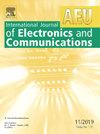Electronically controlled square/triangular wave generator with amplitude adjustability and its application in light intensity measurement using commercial-off-the-shelf current feedback amplifiers
IF 3
3区 计算机科学
Q2 ENGINEERING, ELECTRICAL & ELECTRONIC
Aeu-International Journal of Electronics and Communications
Pub Date : 2025-05-05
DOI:10.1016/j.aeue.2025.155840
引用次数: 0
Abstract
This study presents a square and triangular waveform generator using two commercial-off-the-shelf current feedback amplifiers with DC gain control, LT1228. The frequency of the square and triangular waveforms can be electronically and independently adjusted with the bias current. With this advantage feature, the proposed generator can be easily modified to generate a sawtooth waveform and electronically adjust the duty cycle of square waves. Additionally, PWM signals can also be generated from the proposed circuit. The amplitude of both square and triangular waveforms is adjustable without affecting the frequency, and the output nodes have low impedance. The circuit’s performance is validated through practical implementation and testing, showing excellent agreement with theoretical analysis. The measured linear and electronic adjustment of frequency spanned from 4.83 kHz to 436.2 kHz. Furthermore, the circuit can be applied as a low-cost light intensity detection sensor.
具有幅值可调的电控方波/三角波发生器及其在利用现成的电流反馈放大器进行光强测量中的应用
本研究提出了一个方形和三角形波形发生器,使用两个商用现货电流反馈放大器与直流增益控制,LT1228。方形和三角形波形的频率可以通过电子方式独立地随偏置电流调节。有了这个优点,所提出的发生器可以很容易地修改,以产生锯齿波形和电子调整方波的占空比。此外,所提出的电路也可以产生PWM信号。方形和三角形波形的幅值可调,不影响频率,输出节点阻抗低。通过实际实现和测试,验证了电路的性能,与理论分析结果吻合良好。测量的线性和电子频率调整范围从4.83 kHz到436.2 kHz。此外,该电路还可作为低成本的光强检测传感器。
本文章由计算机程序翻译,如有差异,请以英文原文为准。
求助全文
约1分钟内获得全文
求助全文
来源期刊
CiteScore
6.90
自引率
18.80%
发文量
292
审稿时长
4.9 months
期刊介绍:
AEÜ is an international scientific journal which publishes both original works and invited tutorials. The journal''s scope covers all aspects of theory and design of circuits, systems and devices for electronics, signal processing, and communication, including:
signal and system theory, digital signal processing
network theory and circuit design
information theory, communication theory and techniques, modulation, source and channel coding
switching theory and techniques, communication protocols
optical communications
microwave theory and techniques, radar, sonar
antennas, wave propagation
AEÜ publishes full papers and letters with very short turn around time but a high standard review process. Review cycles are typically finished within twelve weeks by application of modern electronic communication facilities.

 求助内容:
求助内容: 应助结果提醒方式:
应助结果提醒方式:


